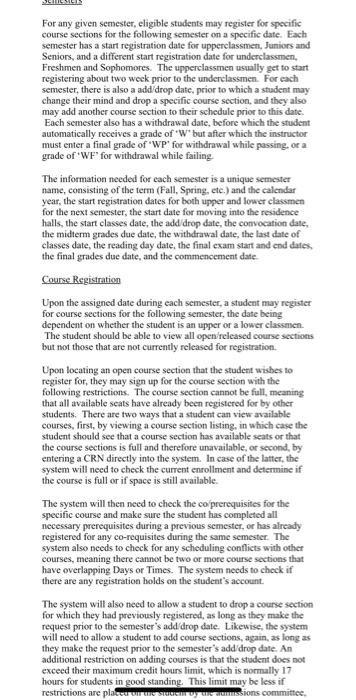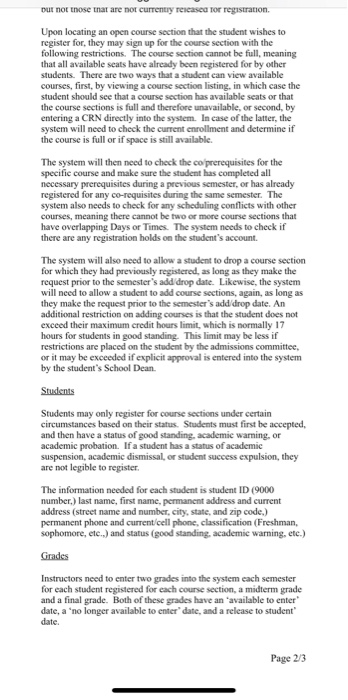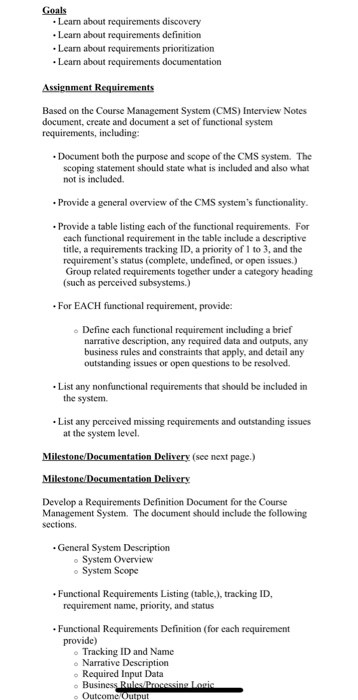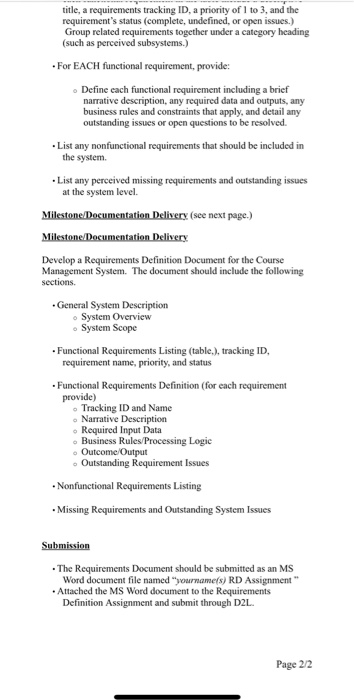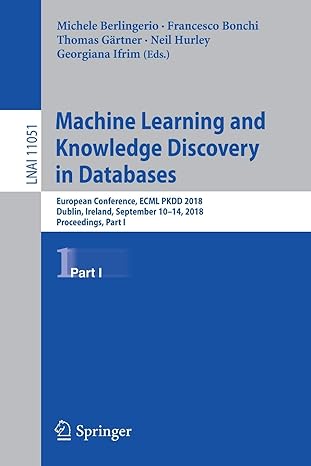Please ans full. Dont ans half or little part of it
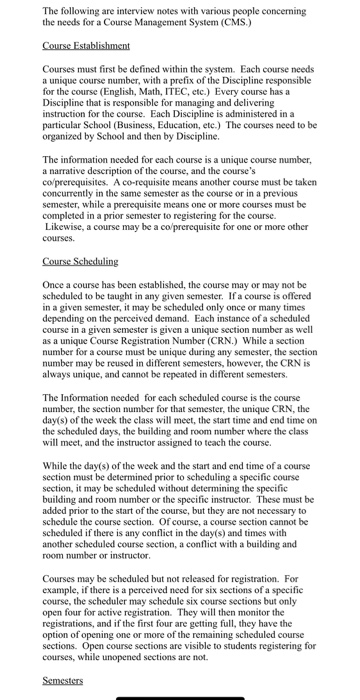
The following are interview notes with various people concerning the needs for a Course Management System (CMS.) Courses must first be defined within the system. Each course needs a unique course number, with a prefix of the Discipline responsible for the course (English, Math, ITEC, etc.) Every course has a Discipline that is responsible for managing and delivering instruction for the course. Each Discipline is administered in a particular School (Business, Education, etc.) The courses need to be organized by School and then by Discipline. The information needed for each course is a unique course number, a narrative description of the course, and the course's co/prerequisites. A co-requisite means another course must be taken concurrently in the same semester as the course or in a previous semester, while a prerequisite means one or more courses must be completed in a prior semester to registering for the course. Likewise, a course may be a co prerequisite for one or more other Once a course has been established, the course may or may not be scheduled to be taught in any given semester. If a course is offered in a given semester, it may be scheduled only once or many times depending on the perceived demand. Each instance of a scheduled course in a given semester is given a unique section number as well as a unique Course Registration Number (CRN.) While a section number for a course must be unique during any semester, the section number may be reused in different semesters, however, the CRN is always unique, and cannot be repeated in different semesters. The Information needed for cach scheduled course is the course number, the section number for that semester, the unique CRN, the day(s) of the week the class will meet, the start time and end time on the scheduled days, the building and room number where the class will meet, and the instructor assigned to teach the course. While the day(s) of the week and the start and end time of a course section must be determined prior to scheduling a specific course section, it may be scheduled without determining the specific building and room number or the specific instructor. These must be added prior to the start of the course, but they are not necessary to schedule the course section. Of course, a course section cannot be scheduled if there is any conflict in the day(s) and times with another scheduled course section, a conflict with a building and room number or instructor Courses may be scheduled but not released for registration. For example, if there is a perceived need for six sections of a specifie course, the scheduler may schedule six course sections but only open four for active registration. They will then monitor the registrations, and if the first four are getting full, they have the option of opening one or more of the remaining scheduled course sections. Open course sections are visible to students registering for courses, while unopened sections are not. For any given semester, eligible students may register for specific course sections for the following semester on a specific date. Each semester has a start registration date for upperclassmen, Juniors and Seniors, and a different start registration date for underclassmen, Freshmen and Sophomores. The upperclassmen usually get to start registering about two week prior to the underclassmen. For each semester, there is also a add drop date, prior to which a student may change their mind and drop a specific course section, and they also may add another course section to their schedule Each semester also has a withdrawal date, before which the student automatically receives a grade of W" but after which the instructor must enter a final grade of WP" for withdrawal while passing. or a grade of WF' for withdrawal while failing prior to this date. The information needed for each semester is a unique semester name, consisting of the term (Fall, Spring, etc.) and the calendar year, the start registration dates for both upper and lower classmen for the next semester, the start date for moving into the residence halls, the start classes date, the add drop date, the convocation date, the midterm grades due date, the withdrawal date, the last date of classes date, the reading day date, the final exam start and end dates, the final grades due date, and the commencement date. Upon the assigned date during each semester, a student may register for course sections for the following semester, the date being dependent on whether the student is an upper or a lower classmen. The student should be able to view all open released course sections but not those that are not currently released for registration Upon locating an open course section that the student wishes to register for, they may sign up for the course section with the following restrictions. The course section cannot be full, meaning that all available seats have already been registered for by other students. There are two ways that a student can view available courses, first, by viewing a course section listing, in which case the student should see that a course section has available seats or that the course sections is full and therefore unavailable, or second, by entering a CRN directly into the system. In case of the latter, the system will need to check the current enrollment and determine if the course is full or if is still available The system will then need to check the coprerequisites for the specific course and make sure the student has completed all necessary prerequisites during a previous semester, or has already registered for any co-requisites during the same semester. The system also needs to check for any scheduling conflicts with other courses, meaning have overlapping Days or Times. The system needs to check if there are any registration holds on the student's account. there cannot be two or more course sections that The system will also need to allow a student to drop a course section for which they had previously registered, as long as they make the request prior to the semester's add drop date. Likewise, the system will need to allow a student to add course sections, again, as long as they make the request prior to the semester's adddrop date. An additional restriction on adding courses is exceed their maximum credit hours limit, which is normally 17 hours for students in good standing, This limit may be less if restictions are that the stadent does not ut not tnose tnat are not currentry recasca tor registration Upon locating an open course section that the student wishes to register for, they may sign up for the course section with the that all available seats have already been registered for by other courses, first, by viewing a course section listing, in which case the student should see that a course section has available seats or that the course sections is full and therefore unavailable, or second, by entering a CRN directly into the system. In case of the latter, the system will need to check the current enrollment and determine if the course is full or if space is The system will then need to check the co prerequisites for the specific course and make sure the student has completed all necessary prerequisites during a previous semester, or has already registered for any co-requisites during the same semester. The system also needs to check for any scheduling conflicts with other courses, meaning there cannot be two or more course sections that have overlapping Days or Times. The system needs to check if there are any registration holds on the student's account. The system will also need to allow a student to drop a course section for which they had previously registered, as long as they make the request prior to the semester's add drop date. Likewise, the system will need to allow a student to add course sections, again, as long as they make the request prior to the semester's add drop date. An additional restriction on adding courses is that the student does not exceed their maximum credit hours limit, which is normally 17 hours for students in good standing. This limit may be less if restrictions are placed on the student by the admissions committee, or it may be exceeded if explicit approval is entered into the system by the student's School Dean. and then have a status of good standing, academie warning, or academic probation. If a student has a status of academic suspension, academic dismissal, or student success expulsion, they are not legible to register The information needed for each student is student ID (9000 number,) last name, first name, permanent address and current address (street name and number, city, state, and zip code,) permanent phone and current/cell phone, classification (Freshman, sophomore, etc.) and status (good standing, academic warning, etc.) Instructors need to enter two grades into the system each semester for each student registered for each course section, a midterm grade and a final grade. Both of these grades have an 'available to enter date, a no longer available to enter" date, and a release to studernt Page 2/3 Goals Learn about requirements discovery Learn about requirements definition Learn about requirements prioritization Learn about requirements documentation Based on the Course Management System (CMS) Interview Notes document, create and document a set of functional system requirements, including: Document both the purpose and scope of the CMS system. The scoping statement should state what is included and also what not is included. Provide a general overview of the CMS system's functionality Provide a table listing each of the functional requirements. For each functional requirement in the table include a descriptive title, a requirements tracking ID, a priority of 1 to 3, and the requirement's status (complete, undefined, or open issues.) Group related requirements together under a category heading (such as perceived subsystems.) For EACH functional requirement, provide: o Define each functional requirement including a brief outstanding issues or open questions to be resolved List any nonfunctional requirements that should be included in List any perceived missing requirements and outstanding issues narrative description, any required data and outputs, any business rules and constraints that apply, and detail any the system. at the system level. (see next page.) Develop a Requirements Definition Document for the Course Management System. The document should include the following sections General System Description o System Overview o System Scope Functional Requirements Listing (table.), tracking ID, requirement name, priority, and status Functional Requirements Definition (for each requirement provide) Tracking ID and Name Narrative Description o Required Input Data o Business lEcessine aa o Outcome O title, a requirements tracking ID, a priority of 1 to 3, and the requirement's status (complete, undefined, or open issues.) Group related requirements together under a category heading (such as perceived subsystems.) For EACH functional requirement, provide: o Define cach functional requirement including a brietf narrative description, any required data and outputs, any business rules and constraints that apply, and detail any List any nonfunctional requirements that should be included in List any perceived missing requirements and outstanding issues outstanding issues or open questions to be resolved. at the system level. Develop a Requirements Definition Document for the Course Management System. The document should include the following Functional Requirements Listing (table,), tracking ID, requirement name, priority, and status Functional Requirements Definition (for each requirement provide) Business Rules/Processing Logic o Outcome Output Missing Requirements and Outstanding System Issues The Requirements Document should be submitted as an MS Word document file named "yourname(s) RD Assignment" Attached the MS Word document to the Requirements Definition Assignment and submit through D2L Page 2/2 The following are interview notes with various people concerning the needs for a Course Management System (CMS.) Courses must first be defined within the system. Each course needs a unique course number, with a prefix of the Discipline responsible for the course (English, Math, ITEC, etc.) Every course has a Discipline that is responsible for managing and delivering instruction for the course. Each Discipline is administered in a particular School (Business, Education, etc.) The courses need to be organized by School and then by Discipline. The information needed for each course is a unique course number, a narrative description of the course, and the course's co/prerequisites. A co-requisite means another course must be taken concurrently in the same semester as the course or in a previous semester, while a prerequisite means one or more courses must be completed in a prior semester to registering for the course. Likewise, a course may be a co prerequisite for one or more other Once a course has been established, the course may or may not be scheduled to be taught in any given semester. If a course is offered in a given semester, it may be scheduled only once or many times depending on the perceived demand. Each instance of a scheduled course in a given semester is given a unique section number as well as a unique Course Registration Number (CRN.) While a section number for a course must be unique during any semester, the section number may be reused in different semesters, however, the CRN is always unique, and cannot be repeated in different semesters. The Information needed for cach scheduled course is the course number, the section number for that semester, the unique CRN, the day(s) of the week the class will meet, the start time and end time on the scheduled days, the building and room number where the class will meet, and the instructor assigned to teach the course. While the day(s) of the week and the start and end time of a course section must be determined prior to scheduling a specific course section, it may be scheduled without determining the specific building and room number or the specific instructor. These must be added prior to the start of the course, but they are not necessary to schedule the course section. Of course, a course section cannot be scheduled if there is any conflict in the day(s) and times with another scheduled course section, a conflict with a building and room number or instructor Courses may be scheduled but not released for registration. For example, if there is a perceived need for six sections of a specifie course, the scheduler may schedule six course sections but only open four for active registration. They will then monitor the registrations, and if the first four are getting full, they have the option of opening one or more of the remaining scheduled course sections. Open course sections are visible to students registering for courses, while unopened sections are not. For any given semester, eligible students may register for specific course sections for the following semester on a specific date. Each semester has a start registration date for upperclassmen, Juniors and Seniors, and a different start registration date for underclassmen, Freshmen and Sophomores. The upperclassmen usually get to start registering about two week prior to the underclassmen. For each semester, there is also a add drop date, prior to which a student may change their mind and drop a specific course section, and they also may add another course section to their schedule Each semester also has a withdrawal date, before which the student automatically receives a grade of W" but after which the instructor must enter a final grade of WP" for withdrawal while passing. or a grade of WF' for withdrawal while failing prior to this date. The information needed for each semester is a unique semester name, consisting of the term (Fall, Spring, etc.) and the calendar year, the start registration dates for both upper and lower classmen for the next semester, the start date for moving into the residence halls, the start classes date, the add drop date, the convocation date, the midterm grades due date, the withdrawal date, the last date of classes date, the reading day date, the final exam start and end dates, the final grades due date, and the commencement date. Upon the assigned date during each semester, a student may register for course sections for the following semester, the date being dependent on whether the student is an upper or a lower classmen. The student should be able to view all open released course sections but not those that are not currently released for registration Upon locating an open course section that the student wishes to register for, they may sign up for the course section with the following restrictions. The course section cannot be full, meaning that all available seats have already been registered for by other students. There are two ways that a student can view available courses, first, by viewing a course section listing, in which case the student should see that a course section has available seats or that the course sections is full and therefore unavailable, or second, by entering a CRN directly into the system. In case of the latter, the system will need to check the current enrollment and determine if the course is full or if is still available The system will then need to check the coprerequisites for the specific course and make sure the student has completed all necessary prerequisites during a previous semester, or has already registered for any co-requisites during the same semester. The system also needs to check for any scheduling conflicts with other courses, meaning have overlapping Days or Times. The system needs to check if there are any registration holds on the student's account. there cannot be two or more course sections that The system will also need to allow a student to drop a course section for which they had previously registered, as long as they make the request prior to the semester's add drop date. Likewise, the system will need to allow a student to add course sections, again, as long as they make the request prior to the semester's adddrop date. An additional restriction on adding courses is exceed their maximum credit hours limit, which is normally 17 hours for students in good standing, This limit may be less if restictions are that the stadent does not ut not tnose tnat are not currentry recasca tor registration Upon locating an open course section that the student wishes to register for, they may sign up for the course section with the that all available seats have already been registered for by other courses, first, by viewing a course section listing, in which case the student should see that a course section has available seats or that the course sections is full and therefore unavailable, or second, by entering a CRN directly into the system. In case of the latter, the system will need to check the current enrollment and determine if the course is full or if space is The system will then need to check the co prerequisites for the specific course and make sure the student has completed all necessary prerequisites during a previous semester, or has already registered for any co-requisites during the same semester. The system also needs to check for any scheduling conflicts with other courses, meaning there cannot be two or more course sections that have overlapping Days or Times. The system needs to check if there are any registration holds on the student's account. The system will also need to allow a student to drop a course section for which they had previously registered, as long as they make the request prior to the semester's add drop date. Likewise, the system will need to allow a student to add course sections, again, as long as they make the request prior to the semester's add drop date. An additional restriction on adding courses is that the student does not exceed their maximum credit hours limit, which is normally 17 hours for students in good standing. This limit may be less if restrictions are placed on the student by the admissions committee, or it may be exceeded if explicit approval is entered into the system by the student's School Dean. and then have a status of good standing, academie warning, or academic probation. If a student has a status of academic suspension, academic dismissal, or student success expulsion, they are not legible to register The information needed for each student is student ID (9000 number,) last name, first name, permanent address and current address (street name and number, city, state, and zip code,) permanent phone and current/cell phone, classification (Freshman, sophomore, etc.) and status (good standing, academic warning, etc.) Instructors need to enter two grades into the system each semester for each student registered for each course section, a midterm grade and a final grade. Both of these grades have an 'available to enter date, a no longer available to enter" date, and a release to studernt Page 2/3 Goals Learn about requirements discovery Learn about requirements definition Learn about requirements prioritization Learn about requirements documentation Based on the Course Management System (CMS) Interview Notes document, create and document a set of functional system requirements, including: Document both the purpose and scope of the CMS system. The scoping statement should state what is included and also what not is included. Provide a general overview of the CMS system's functionality Provide a table listing each of the functional requirements. For each functional requirement in the table include a descriptive title, a requirements tracking ID, a priority of 1 to 3, and the requirement's status (complete, undefined, or open issues.) Group related requirements together under a category heading (such as perceived subsystems.) For EACH functional requirement, provide: o Define each functional requirement including a brief outstanding issues or open questions to be resolved List any nonfunctional requirements that should be included in List any perceived missing requirements and outstanding issues narrative description, any required data and outputs, any business rules and constraints that apply, and detail any the system. at the system level. (see next page.) Develop a Requirements Definition Document for the Course Management System. The document should include the following sections General System Description o System Overview o System Scope Functional Requirements Listing (table.), tracking ID, requirement name, priority, and status Functional Requirements Definition (for each requirement provide) Tracking ID and Name Narrative Description o Required Input Data o Business lEcessine aa o Outcome O title, a requirements tracking ID, a priority of 1 to 3, and the requirement's status (complete, undefined, or open issues.) Group related requirements together under a category heading (such as perceived subsystems.) For EACH functional requirement, provide: o Define cach functional requirement including a brietf narrative description, any required data and outputs, any business rules and constraints that apply, and detail any List any nonfunctional requirements that should be included in List any perceived missing requirements and outstanding issues outstanding issues or open questions to be resolved. at the system level. Develop a Requirements Definition Document for the Course Management System. The document should include the following Functional Requirements Listing (table,), tracking ID, requirement name, priority, and status Functional Requirements Definition (for each requirement provide) Business Rules/Processing Logic o Outcome Output Missing Requirements and Outstanding System Issues The Requirements Document should be submitted as an MS Word document file named "yourname(s) RD Assignment" Attached the MS Word document to the Requirements Definition Assignment and submit through D2L Page 2/2


